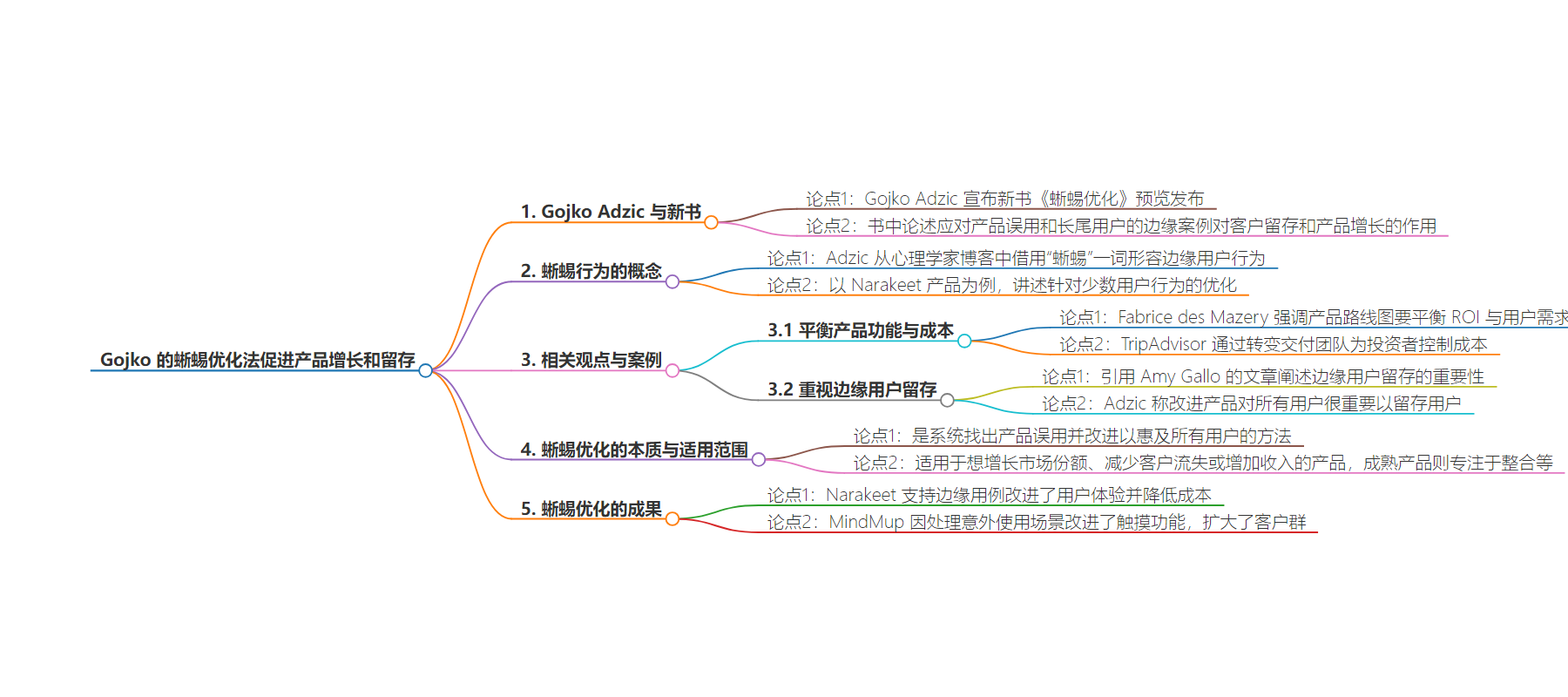包阅导读总结
1. 关键词:Lizard Optimization、Product Growth、Customer Retention、Marginal Use-Cases、User Experience
2. 总结:
Gojko Adzic 提出 Lizard Optimization,通过关注产品的误用和边缘少数用户的特殊情况来促进客户留存和产品增长,强调保留边缘用户的重要性,以改善产品并提升用户体验。
3. 主要内容:
– Gojko Adzic 宣布预览发布 Lizard Optimization 一书
– 讲述应对产品误用和少数长尾用户的边缘情况对客户留存和产品增长的作用
– 以 Narakeet 为例
– 原为生成 PPT 视频,少数人用于制作空白视频和提取音频
– 为少数用户优化后,此类需求大幅增长
– 引用相关观点
– 参考 Fabrice des Mazery 关于平衡产品路线图的成本和盈利能力的观点
– 援引 Amy Gallo 关于保留边缘客户重要性的文章
– 强调 Lizard Optimization 的适用场景
– 适用于想增长市场份额等的产品
– 产品成熟时则专注于整合等
思维导图:
文章来源:infoq.com
作者:Rafiq Gemmail
发布时间:2024/7/31 0:00
语言:英文
总字数:661字
预计阅读时间:3分钟
评分:89分
标签:产品增长,客户留存,用户体验改进,产品简化,边缘用例
以下为原文内容
本内容来源于用户推荐转载,旨在分享知识与观点,如有侵权请联系删除 联系邮箱 media@ilingban.com
Gojko Adzic, author of Impact Mapping and many other classic product, engineering and testing books, recently announced the preview release of Lizard Optimization. His latest book discusses how responding to product-misuse and marginal corner-cases of the few long-tail users helped drive customer retention, and accelerate product growth. Continuous Delivery author, Dave Farley, recently interviewed Adzicfor the GOTO Book Club, to discuss how these unusual use-cases can drive delivery of a better product for all customers.
Talking with Farley about feature areas to target for new product growth, Adzic discussed honing in on the curious and hard-to-understand use cases of small groups who appear to be misusing a product. Adzic referred to these use cases as “lizard behaviours.” He took the term “lizard” from a 2013 blog by psychologist Scott Alexander about surveying small groups with marginally held beliefs, such as those believing in conspiracies about lizards. Adzic told his own Lizard Optimization story of pivoting Narakeet, a product originally designed to generate narrated videos of PowerPoint presentations. He said:
The tool started as a way to make videos from PowerPoint. There were some people constantly making blank videos and paying me for that. Which made no sense at all … They were going through hoops and extracting videos just to produce an audio track… I simplified the way for those people to create just the audio file… That tiny minority, which was 1%, overtime became more than 99%.
InfoQ’s Ben Linders recently reported on a FlowCon France talk given by Fabrice des Mazery, CPO at TripAdvisor, where he discussed the cost and profitability risks of over-focusing on adding product features “because it’s better for the user.” Des Mazery cautioned that it’s important to take a broader ROI-centric focus to product roadmaps, which balance user-centric evolution of the product with longer-term profitability. TripAdvisor achieved this by transforming delivery teams into investors, with caps placed on cost. In Narakeet’s case, Adzic shared that adding support for the marginal use-case of a text-to-speech feature had resulted in improved UX and a significant reduction in operational cost.
Citing The Value of Keeping the Right Customers, a 2014 Harvard Business Review article by Amy Gallo, Adzic expressed the importance of retaining even those customers with marginal use cases, as marginal retention has a “compounding impact” on revenue. Gallo’s original article reported that “increasing customer retention rates by 5% increases profits by 25% to 95%.” Adzictold Farley that driving product improvements for all users was important for customer retention. He claimed:
If you want to grow a product, you can either go and acquire new users, or increase the retention of your existing users. And retaining users is incredibly more profitable at certain points of the life cycle.
A repeated point made by Adzic in his conversation with Farley was that by targeting marginal-use cases, one can make simplifications and overarching improvements across the product for “all users.” Another example he provided was that of a bug report filed about his mind-mapping application, MindMup, not being usable on a smart fridge. While this was not a use case he’d planned for, Adzic shared that by improving the touch capabilities of the application, they delivered usability improvements for all users, and widened the customer base. He explained:
Lizard Optimisation is a systematic way of figuring out how people are misusing a product, and then using those signals to make the product better. By making a product better for people who are misusing it, we can make a product better for everybody.
Within the book itself, Adzic calls out that Lizard Optimization is suited to products “where you want to grow market share, reduce churn or increase revenue.” He also explicitly calls out that for a product which is already “very mature,” having reached a point where you no longer need to grow it, then it is better to “focus on consolidation, technical scaling and reducing operating costs.” Lizard Optimization is in draft and available on LeanPub.
